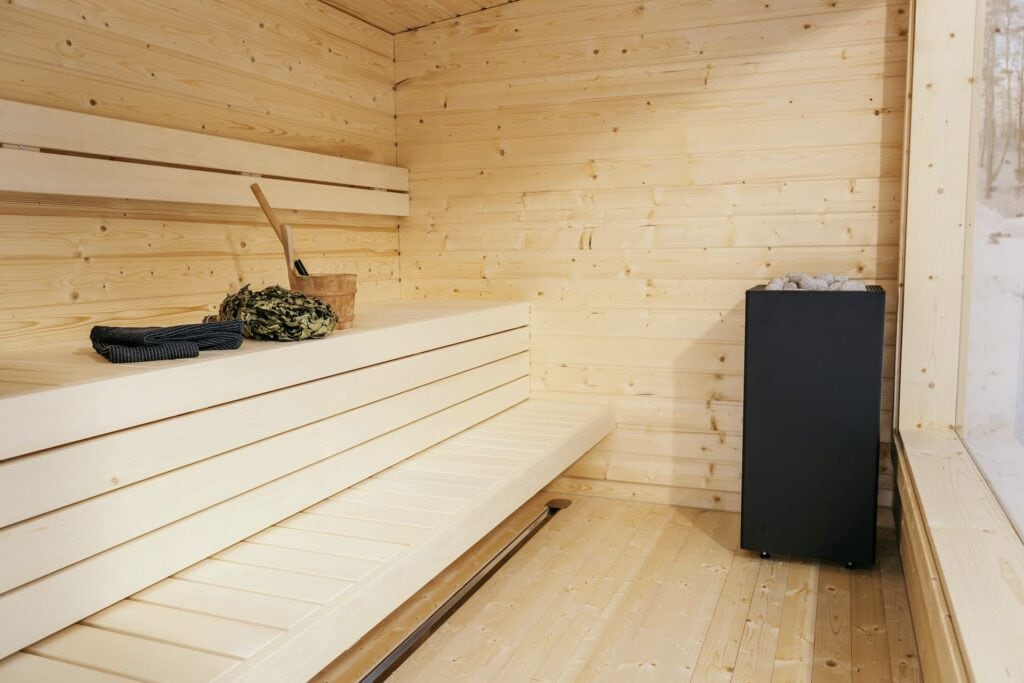Did you know that sauna sessions have been loved for centuries for their relaxation and health benefits? Whether you prefer the dry heat of a traditional sauna or the infrared warmth of modern saunas, knowing how long to stay in a sauna is essential for a safe and enjoyable experience.
Depending on various factors, the time spent inside a sauna varies. Having this knowledge confirms you enjoy a safe spa experience that maximizes the wellness advantages these heat sessions offer.
What Is a Sauna?
A regular sauna is a room or house designed to provide heat therapy, which can help people relax and relieve stress. It typically has wooden interiors and is heated by either wood or electricity. The heat in a traditional sauna warms the air, which then warms your body, leading to perspiration.
This heat and subsequent sweating can stimulate blood circulation, relaxation, and other health benefits. The temperature in a sauna may range between 150-195 degrees Fahrenheit (60-90 Celsius), although infrared saunas usually operate at a lower temperature.
How Long Is the Recommended Duration to Stay in a Sauna?
How long to stay in a sauna often generates a lot of discussion. The length of time you spend depends largely on an individual’s comfort level and previous exposure to saunas. The consensus among experts dealing with these questions tends to suggest staying in a sauna for between 15 and 20 minutes each session.
Just like with any health and wellness activity, it’s also essential to know how to cool down properly. Gradually reducing your body temperature after a sauna session is essential to prevent lightheadedness and maintain balance. So, if you are often wondering how long to stay in a sauna, keep in mind that comfort, experience, and a proper cooling period afterward are the key factors to consider.

What Are the Factors Affecting Sauna Duration?
Hydration Status
Your body’s hydration status significantly affects how long you can stay in a sauna. Dehydration can induce heat stress, which can expedite heat exhaustion. This condition could lead to dangerous circumstances like muscle cramps and mental fog, increasing the risk of dementia if repetitive. So, it’s important to drink plenty of water before, during, and after a sauna session, especially if you’re enjoying the wet heat of a wet sauna.
Health Condition
Your total wellness and existing health conditions play a critical role in determining the appropriate sauna protocols, such as duration and frequency. For instance, if you have pre-existing health issues like heart disease, which could affect your heart rate or muscle soreness, it’s important to consult with a healthcare professional.
They can guide you to start on shorter sauna sessions and gradual increases, helping you reap maximum benefits without endangering your health. Particularly, pregnant women and those experiencing chronic pain should consult their doctor and are likely to limit sauna use.
Individual Tolerance to Heat
Personal tolerance to heat greatly impacts how long one can comfortably stay in a hot sauna. Some people may find that traditional heat therapy can ease muscle tension, improve muscle recovery, and even regulate blood pressure, allowing them to stay longer. However, others might feel light-headed or uncomfortable after a short amount of time, which could be an indication of fluctuating blood pressure.
Experimenting with shorter sessions and gradually increasing the duration as you acclimate to the heat can be both a safe and efficient approach.
Age and Cold Plunge
Age is another significant factor that impacts sauna duration. Older adults and children may be more susceptible to the effects of heat. The elderly are advised to have shorter sessions, around 5-10 minutes, including a cold plunge if comfortable to prevent overheating. Children should always be supervised, and their sauna duration should be strictly controlled.
Temperature of the Sauna
The temperature of the sauna can also impact the duration of your stay. In general, the hotter the sauna, the shorter the recommended duration. Traditional saunas are set at a temperature of around 140-200 degrees Fahrenheit (60-93.3 Celcius), and you may only want to stay for around 20-30 minutes.
However, modern saunas, like infrared ones, operate at a lower temperature, between 131-140 degrees Fahrenheit (55-60 Celcius). For many, this temperature range is the sweet spot, allowing you to stay longer to achieve the desirable relaxation and post-workout recovery benefits.
Experience the Rejuvenating Power of a Sauna Session: Reach Out to Home Saunas Today
Knowing how long to stay in a sauna is essential for optimizing your sauna experience and reaping the numerous health benefits it offers. Whether you prefer the intense heat of a traditional sauna or the gentle warmth of an infrared sauna, listening to your body and following the recommended guidelines can help you make the most of your sauna sessions.
Ready to experience the rejuvenating benefits of sauna sessions? Contact Home Saunas for a tranquil retreat and discover the transformative effects on your well-being. At Home Saunas, our dedicated team prioritizes your well-being and offers a serene environment for your sauna journey.